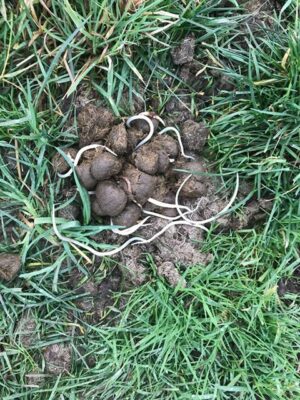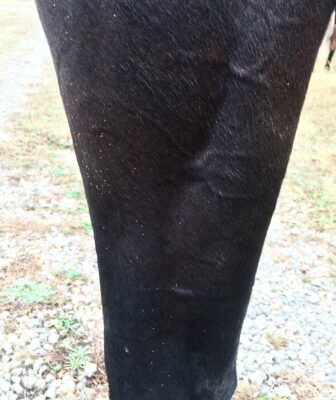Veterinary, Worming
What happens if I don’t deworm my horse?
Rebecca Watson MSc RVN, gives us an insight as to what happens to our horses if we don’t deworm them correctly
There are five main categories of worms that affect our horses in the British Isles, all of which can potentially cause disease of varying severity. In no particular order, they are:

Roundworms
Roundworms or ‘ascarids’, commonly only affect young horses (<4yo), as horses age, they tend to get resistant to them. Roundworms can grow up to 30cm in length.
Due to their large size, in heavy infestations they can cause harm by blocking the intestines, causing impaction colic and, can even rupture the gut. This can obviously be fatal and may require emergency colic surgery or, euthanasia in extreme cases.
Clinical signs of roundworms include coughing, nasal discharge, depression, a rough coat, impaction colic, weight loss or a struggle to maintain or put weight on. Faecal worm egg counts (FWECs) will pick up roundworm infection.
Tapeworms
Tapeworms or ‘cestodes’ affect all ages of horses and infections are commonly associated with idiopathic spasmodic colic. Other clinical signs include weight loss, colitis, diarrhoea and impaction colic. In cases of extreme infestation, tapeworms can be fatal. Tapeworm eggs cannot be picked up on FWECs as they are housed in ‘segments’, however, their presence can be identified using a saliva test or a blood test, which measures antibodies produced in response to exposure to tapeworm parasites. These tests can accurately detect the level of tapeworm infection in and will indicate whether treatment is required or not.
Small redworms
Small roundworms or ‘cyathostomins’ are the most common and can be the most dangerous internal parasite for the horse. Small redworms can live on grazing for long periods of time and they can reproduce rapidly. Horses do not build up immunity to small redworms and as a result, they are emerging as one of parasites that are most resistant to de-wormers.
The adult small redworms feed on intestinal tissue, large infestations can cause serious damage to the gut wall. They are one of the most common causes of spasmodic colic, particularly in young horses. Small redworms can burrow into the gut wall at the larval stage, where they then hibernate. These, so called, ‘encysted’ cyathostomins can lie dormant for months or even years. When large amounts of these larvae emerge (usually in late winter or early spring) they can cause massive damage to the intestines. Untreated small redworm infestation will obviously reduce the horse’s ability to absorb nutrients due to the damaged gut wall and, will cause weight loss, diarrhoea, colic or even death in extreme cases.
“there is no such thing as a one size fits all de-worming programme”
Clinical signs of small redworms vary so they can be tricky to diagnose. FEWCs can detect an adult small redworm burden, however, it will not detect the encysted cyathostomins, as they do not lay eggs. There is now a blood test available to diagnose the encysted larvae. Some horses can appear perfectly healthy even if they have a significant burden of encysted cyathostomins; disease only becomes apparent as the larvae emerge from the gut wall causing a crisis. The use of a de-wormer for adult redworms can cause any encysted redworms to emerge and trigger an acute response.
Large redworms
Large redworms or ‘strongyles’ live in the horse’s intestine as adults, where they reproduce and lay eggs. The eggs are then passed in the faeces, onto pasture where they are eaten by the horse. The larvae hatch from the eggs and then burrow or migrate through the horse’s body. Depending on the species of strongyle, they seek out either the blood vessels or the liver to mature in. Then they burrow back into the intestine, as adults, to begin the cycle again. This burrowing through the tissues can cause untold damage to blood vessels and the to the liver.
The damage to the blood vessels can cause clots and, can interrupt blood supply and even cut it off completely, causing death to tissues. This is a major contributor to colic if the intestinal blood supply is involved, in the worst cases parts of damaged or dead intestine may need to be surgically removed. Rupture of blood vessels can also occur. Clinical signs of large redworms are colic, anaemia, weight loss, difficulty maintaining or putting on weight, and a dull or lethargic demeanour. Large redworms can be detected on a FWEC.

Bots
Bots or ‘gasterophilus species’ are flies rather than worms. They lay pale yellow eggs on the horse’s limbs, neck and shoulders, and around his muzzle.
The horse ingests the eggs by licking or scratching the site of the egg depsit. The eggs hatch into larvae which enter the horse’s system by the oral route. Once in the mouth the larvae burrow into the gums and tongue. Bot fly larvae can also burrow into the horse’s skin, causing lesions and potential sites for dermal infections.
After around four weeks the larvae migrate from the horse’s mouth to the stomach, where they will attach themselves to the stomach lining. The larvae can remain in the horse’s digestive system for around eight to ten months, before passing in the manure. They then pupate in the soil for three to five weeks before emerging as adults, ready to restart the cycle.
Prevention of bot infestation include measures such as fly repellent and fly sheets. If detected in time, the eggs can be removed or scraped off the coat using a flat metal knife.
Bot fly infestation can cause gastrointestinal issues including ulceration and infection at the attachment site. If large numbers of larvae group in the horse’s stomach they can cause physical blockages which can lead to delayed gastric emptying and impaction colic. The larvae also consume nutrients, making it hard for the horse to maintain weight and can cause poor coat as well as poor body condition. Clinical signs of bot fly infection also include sensitivity of the mouth and dental issues, including problems chewing and loss of appetite. The horse may also develop nasal discharge and sinus infections.
Treatment
The choice of treatment, or de-wormer has become very complex. In addition to an unknown number of management related factors, it depends on the species of parasites that are abundant on the farm, the time of year and most obviously the level of drug resistance among them. There is no such thing as a one size fits all de-worming programme and achieving optimal parasite control has become a challenge that demands veterinary involvement; control practices must be tailored to individual farms and yards. Talk to your veterinary surgeon about which treatment and prevention methods best suit your needs.
